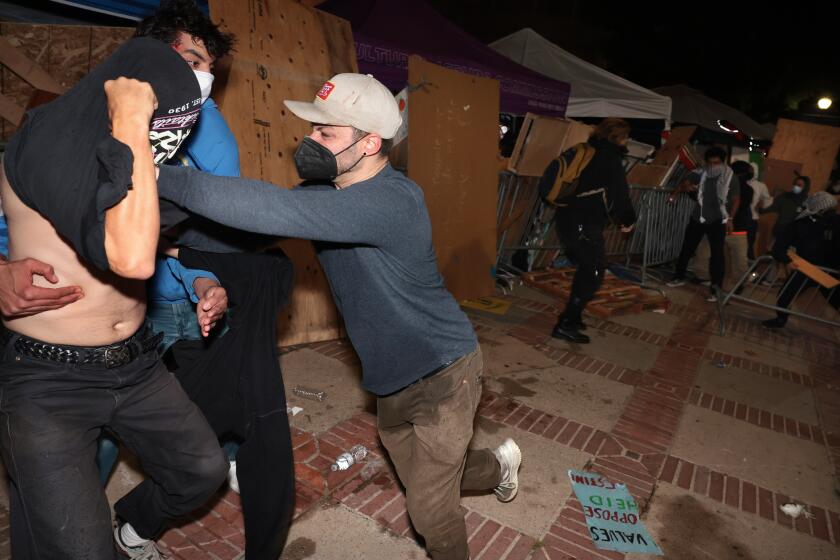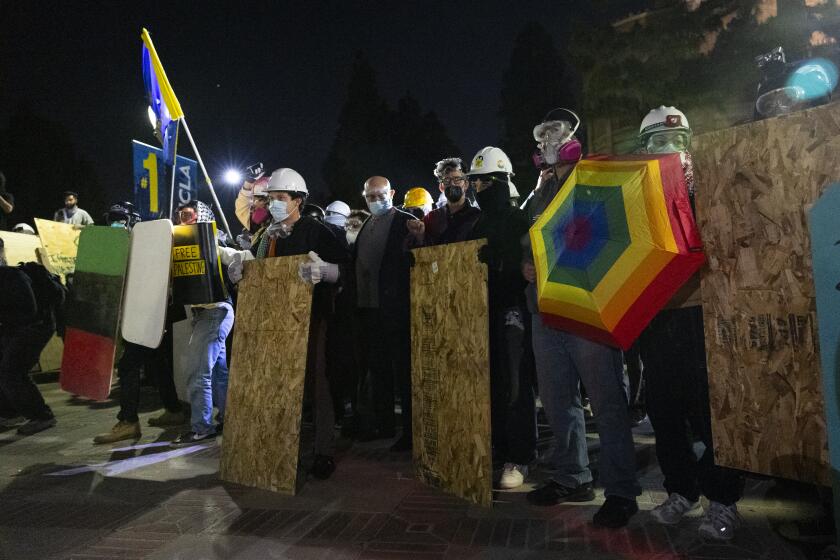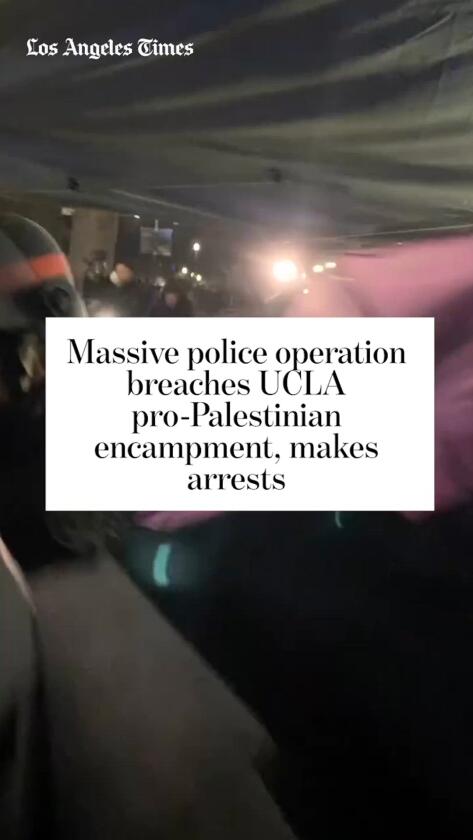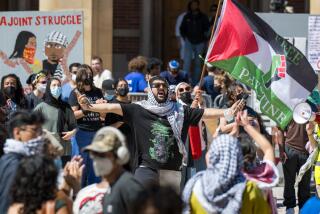
- Share via
UCLA has been roiled by a series of events in the last two weeks surrounding a pro-Palestinian camp formed at the heart of campus.
The encampment was set up April 25, sparking mixed reactions and a largely peaceful counterprotest on April 28.
Two days later, however, UCLA declared the encampment unlawful and directed campus members to leave or face discipline.
Later that night, a violent mob attacked the camp. The few police officers on duty were quickly overwhelmed, and the violence continued for three hours until authorities finally brought the situation under control.
The attack prompted outrage — and questions why UCLA was so ill-prepared to stop the violence. The university’s actions are now the subject of a University of California external review and an internal probe by UCLA, which has put new security procedures in place.
Tensions heightened last week, as UCLA prepared to take down the encampment. Thousands showed up outside the camp in support. Eventually, scores of officers broke into the camp and arrested more than 200 people.
Here is a timeline of what we know about the last two weeks, based on interviews, recordings, social media and documents. The timestamps are our best approximations based on the information we have.
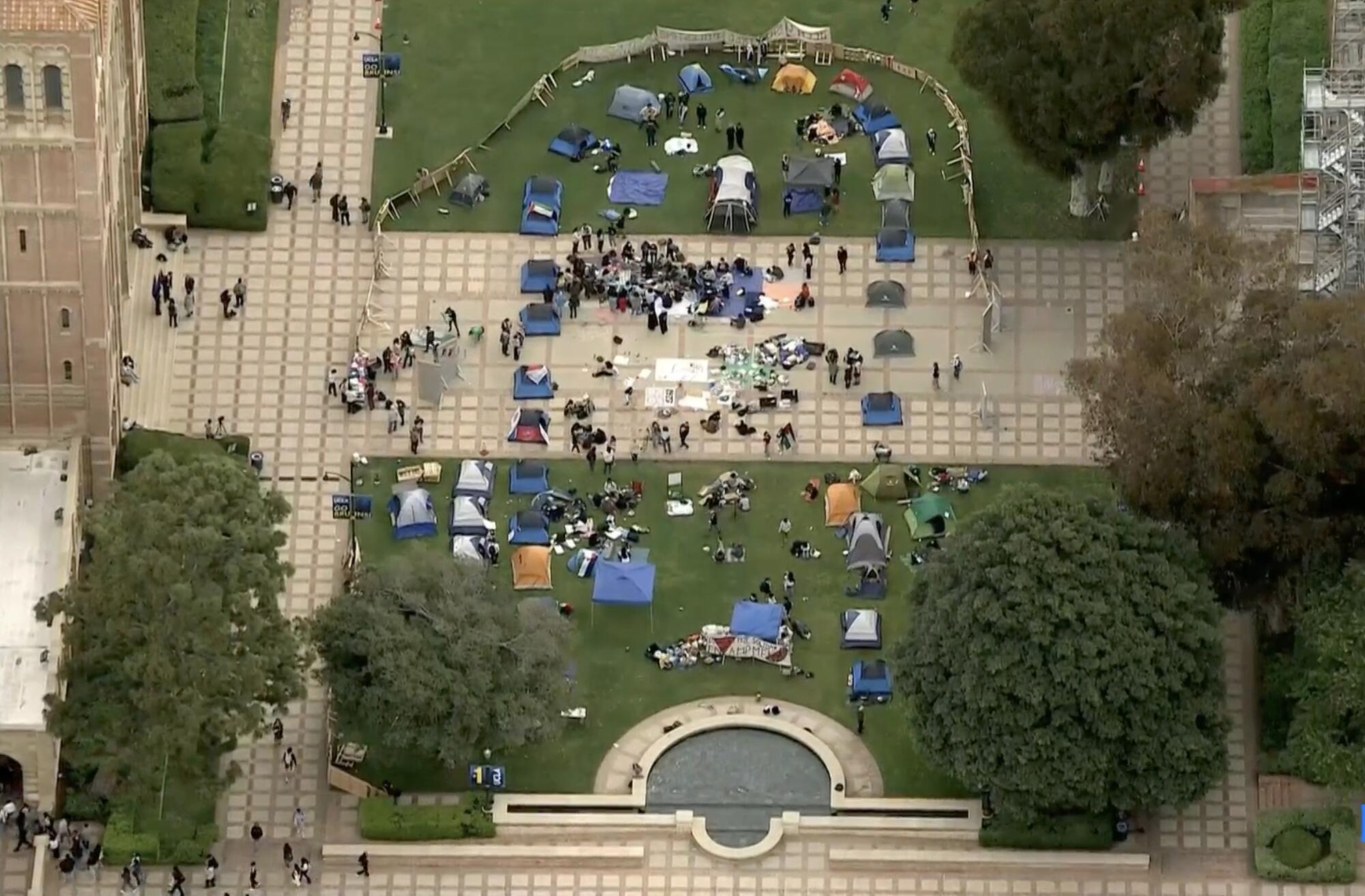
Week of April 21
- As protests over Israel’s actions in Gaza upended universities across the nation and pro-Palestinian protesters set up an encampment at UCLA, campus leadership repeatedly directed UCLA Police Chief John Thomas to create a community safety plan, three sources not authorized to speak publicly told The Times. The chief was told to spare no expense, including overtime pay, to bring in other UC police, external law enforcement and as many private security officers as needed to keep the peace.
- Thomas said campus leadership initially instructed him to develop a plan without the use of police officers, in keeping with UC systemwide guidelines to first rely on communication with protesters and deploy law enforcement as a last resort. He said he developed a plan that relied on private security and made sure to alert the Los Angeles Police Department of the need to respond immediately should problems arise. The private security guards, who were not authorized to make arrests, were instructed to contact UCLA police if needed. Sources, who were not authorized to speak publicly, said Thomas did not deliver the written plan as requested and, after he was authorized to spare no expense for more law enforcement to keep the community safe, failed to do so.
Thomas said he had advised leadership from the beginning not to allow an encampment, since it violated campus rules against overnight camping and he feared it could lead to problems as he assessed other protests sweeping the country. But university leadership, he said, decided to allow the tents “as an expression of students’ 1st Amendment rights.”
UCLA’s chancellor on Monday night outlined actions the school is taking in the aftermath of mob violence against protesters on campus last week.
April 25-26
- The UCLA Police Department asked other campuses for additional police officers five days before the attack. The mutual aid requests — which would have provided UCLA with more officers as they dealt with the camp were canceled. Thomas said he made the requests because the university was tentatively planning to take down the encampment, but he canceled the requests when that plan was delayed.
April 28
- Counterprotesters launched a demonstration next to the camp. Some physical altercations took place, but the dual rallies ended without major violence.
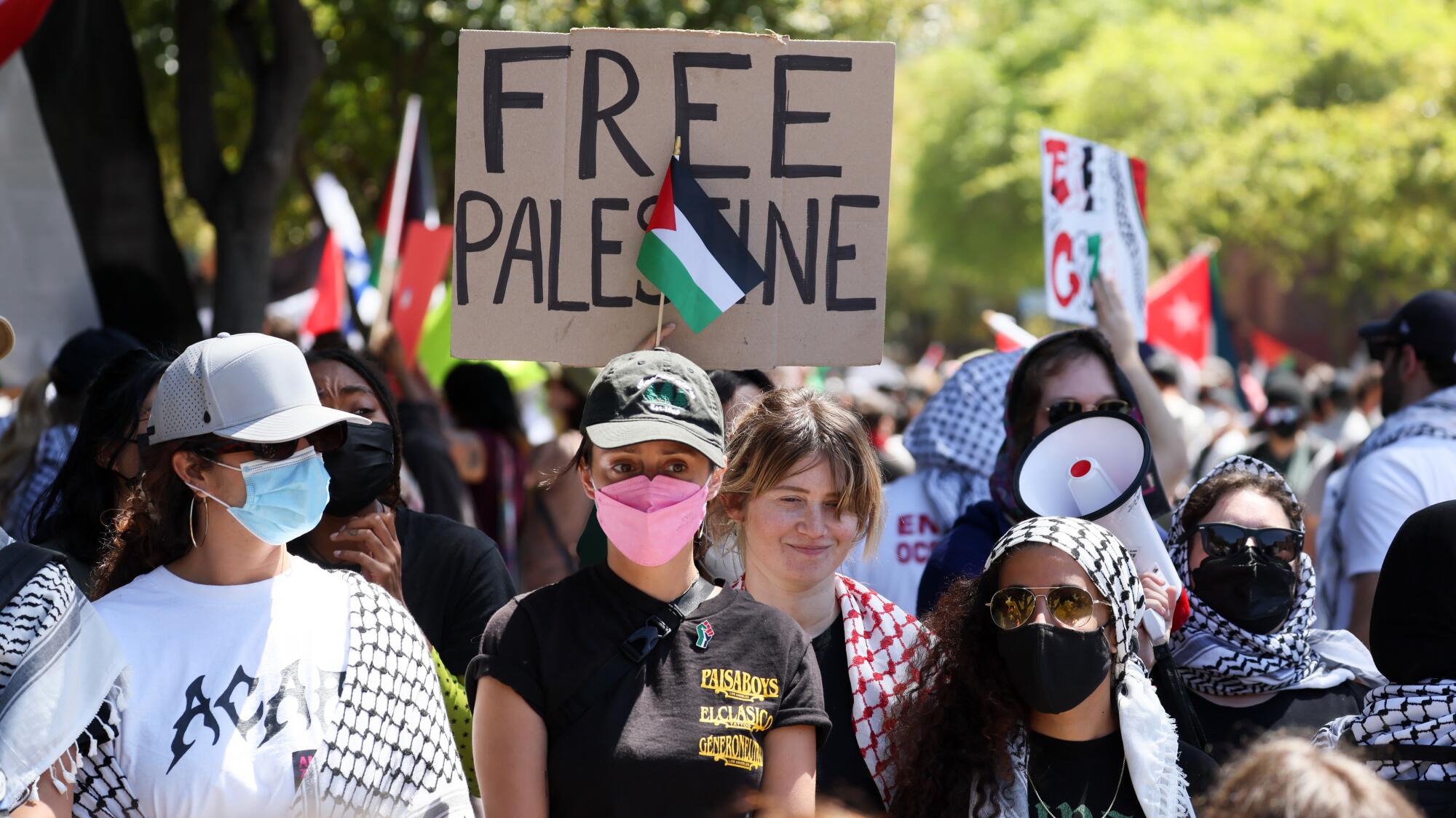
April 29-30
- A Jewish UCLA student was recorded attempting to walk through the camp and being denied access by people who appeared to be protesters. The video went viral, and he was interviewed by Fox News and other outlets.
- Campus leadership reiterated requests to Thomas for a security plan after skirmishes broke out at the dueling rallies, but none was delivered, sources said.
- On April 30, UCLA declared the encampment illegal and warned students and faculty to leave or face discipline.
- Share via
Counterprotesters tried to tear down the barricades surrounding the encampment. Some on campus said they were stunned it took so long before officials stepped in.
- 10:30 p.m. A mob swarmed the campus and began attacking the camp. Thomas said he was home watching the Dodgers game when he was alerted to the problems by Administrative Vice Chancellor Michael Beck, who oversees the UCLA Police Department. Thomas said he immediately called the LAPD’s West L.A. station and asked the watch commander to deploy resources. He then called UCLA’s watch commander and instructed him to call in mutual aid assistance from law enforcement with the cities of Beverly Hills, Culver City and Santa Monica, as well as Los Angeles County sheriff’s deputies. There was a small group of university police on scene with an ambulance, but officials said they were overwhelmed by the crowd and left. Video shows several police cars leaving the area, with someone saying: “Why are you guys leaving? ... Wait. Why is the police leaving? Look at this, they have been told to back down.”
- 11:15 p.m. Videos on social media showed the camp under siege. People wearing black outfits and white masks were seen trying to tear down the barricades surrounding the encampment. Campers, some holding lumber and wearing goggles and helmets, rallied to defend the encampment’s perimeter. Video shows screams erupted as men wrestled a pipe from a masked protester who had emerged from the encampment. A group of people wearing kaffiyehs hustled past the melee, carrying an injured person on a makeshift stretcher.
- 11:45 p.m. Video showed fireworks landing inside the camp and waves of attackers rushing at the barriers that served as the camp boundaries.
- Midnight: Thomas said he arrived on campus shortly before midnight and found that 19 officers from UCLA, the LAPD and three of the mutual aid agencies had arrived but had not moved in to quell the violence. When he asked why, he said an LAPD lieutenant told him the force was too small. Thomas said he asked why they couldn’t go in with the officers they had, and the lieutenant told him he was directed to wait.
- 12:30 a.m. The violence appeared to intensify. Reporters saw people throwing objects at the camp and its occupants and trying to breach the barrier. Campers used pepper spray to defend themselves and their space, but they also came under assault from some type of spray. The Times recorded a group of unarmed security guards observing the scene but not intervening.
 (Michael Blackshire / Los Angeles Times)
(Michael Blackshire / Los Angeles Times)- 12:45 a.m. Mary Osako, vice chancellor for UCLA strategic communications, issued a statement saying: “Horrific acts of violence occurred at the encampment tonight and we immediately called law enforcement for mutual aid support. The fire department and medical personnel are on the scene. We are sickened by this senseless violence and it must end.” A few minutes later, L.A. Mayor Karen Bass also decried the violence and said the LAPD was assisting.
- 1:40 a.m. Police officers in riot gear arrived, and some counterprotesters begin to leave. But police did not immediately break up the clashes, which continued for at least an hour despite law enforcement’s presence. Thomas said it took more than 90 minutes for sufficient forces to arrive and intervene. He said it usually takes an hour or even two to amass “mobile field forces” large enough — 50 officers or more from all over the city.
- 3 a.m. Lines of officers from several agencies arrived at the camp and pushed the remaining crowd members out of the quad area.
- 3:45 a.m. The situation calmed, but people in the camp were still treating those wounded in the attack.
-
Later in the day, UCLA Chancellor Gene Block called the incident “a dark chapter in our campus’s history” and said the university was “carefully examining our own security processes in light of recent events.”
The showdown between law enforcement and protesters on the UCLA campus tested two new journalists, who had no food or helmets but plenty of adrenalin.
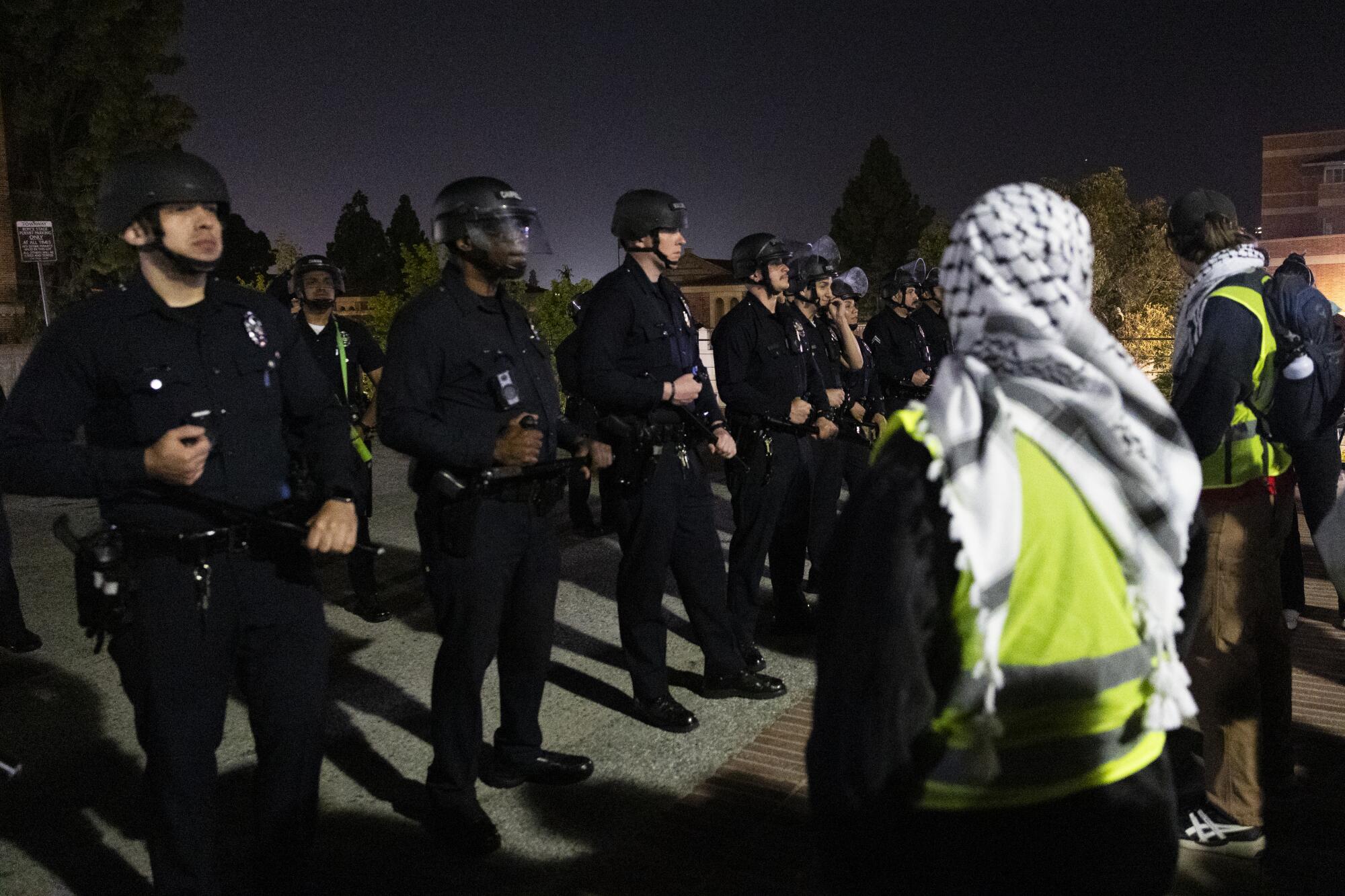
May 1-2
- After a tense day on campus following the attack on the encampment, police further mobilized on campus.
- Share via
- 6 p.m. Police issued an unlawful assembly order, telling those inside the camp to leave.
- 1:30 a.m. A small group of officers entered the camp but left soon after.
- 3 a.m. Scores of officers descended on the camp as the takedown began.
- 4 a.m. After removing barriers and clashing with some protesters, police got into the camp. Reporters witnessed police firing rubber bullets into the crowd before officers began making arrests.
- 6 a.m. The main police operation began to wind down. More than 200 people were arrested.
-
- By midmorning May 2, students, staff and other protesters who had been arrested trickled out of the jail in downtown Los Angeles, carrying plastic bags filled with their belongings and yellow citations.
- Chancellor Block said in a statement that the community was in “deep pain” after the violent incidents. The university’s approach to the encampment had been guided by the desire to support students, free expression and to minimize disruption, but “ultimately, the site became a focal point for serious violence as well as a huge disruption to our campus,” he said.
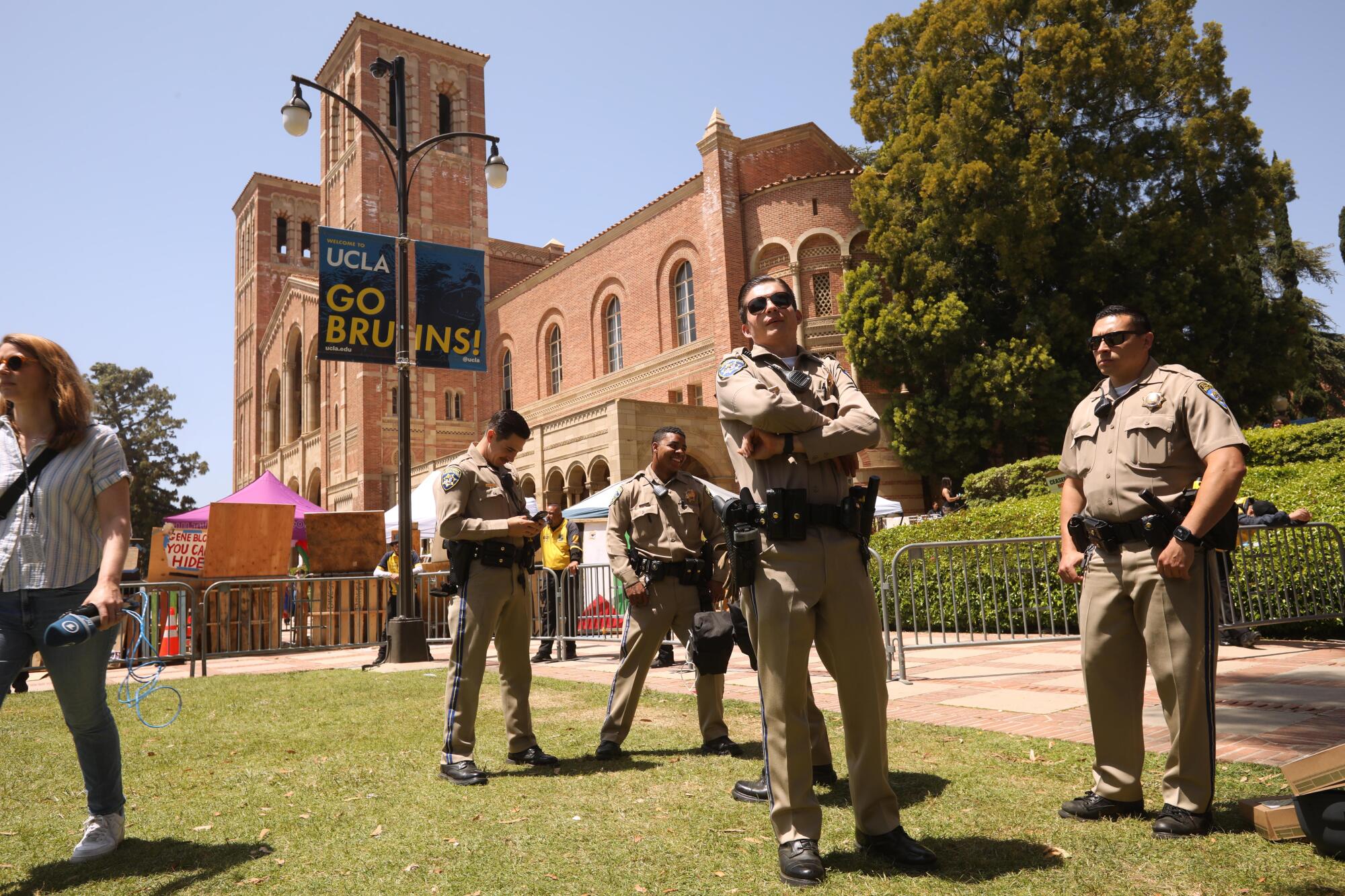
May 3-5
- UCLA Police Chief Thomas faced growing scrutiny for the university’s response to the violent attack on the camp. He told The Times he did “everything I could” to provide security and keep students safe.
- About 20 UCLA faculty members protested outside a gala at the UCLA Hammer Museum, calling for amnesty to be granted to pro-Palestinian students arrested on campus and demanding that Block resign.
- Over the weekend, Block announced the creation of a new position: a chief safety officer who would oversee campus security operations, including the campus Police Department.
- Rick Braziel, a former Sacramento police chief who has reviewed law enforcement responses in high-profile cases across the country, was selected to serve as associate vice chancellor of a new Office of Campus Safety.

May 6-7
- As a new week began, UCLA shifted tactics from a more light-handed approach and brought a larger law enforcement presence to campus.
- As students assembled for what they said would be a peaceful demonstration on campus, police swooped in and arrested 44 pro-Palestinian protesters gathered in a parking structure.
- Other protesters were ordered to disperse when they entered a campus building.
- UCLA moved all classes online for the rest of the week as a security precaution.
- A deeper investigation into the violent attacks continues, with UCLA detectives scanning hundreds of images in an attempt to identify the attackers.
- Block said university police would work with the LAPD and the county district attorney to identify and prosecute “to the fullest extent of the law” those who attacked the pro-Palestinian encampment. The university “also connected with the FBI about possible assistance,” he said in a statement.
More to Read
Sign up for Essential California
The most important California stories and recommendations in your inbox every morning.
You may occasionally receive promotional content from the Los Angeles Times.
